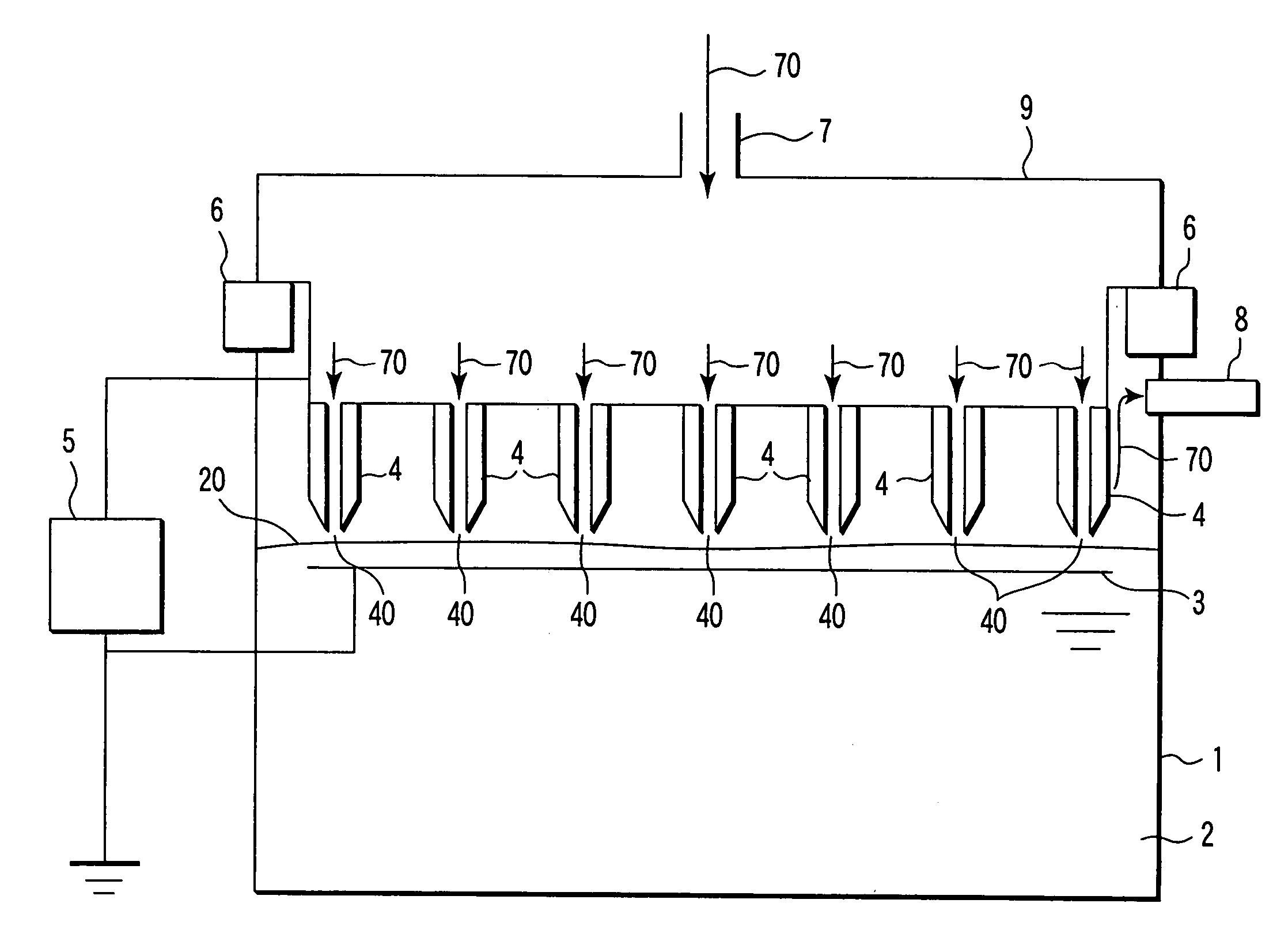Apparatus for decomposing organic matter with radical treatment method using electric discharge
a technology of electric discharge and apparatus, which is applied in water/sewage treatment by oxidation, filtration separation, and separation processes, etc., can solve the problems of inability to decompose recalcitrant organic matter, harmful by-products of disinfection, and inability to achieve the effect of prolonging the life of generated radicals
- Summary
- Abstract
- Description
- Claims
- Application Information
AI Technical Summary
Benefits of technology
Problems solved by technology
Method used
Image
Examples
tenth embodiment
(Tenth Embodiment)
[0167]FIG. 11 is a diagram showing a configuration of a water treatment apparatus according to a tenth embodiment of the invention. In the tenth embodiment, the same configuration as the apparatus shown in FIGS. 1 and 10 is indicated by the same reference numerals, and the detailed description is neglected.
[0168] In the structure of the electrode unit according to the tenth embodiment, the needle-shaped electrode member that is arranged in a through-hole 120 forms the first electrode 4. The through-hole 120 is made in a glass member 12 that is arranged parallel to the second electrode 3. The first electrode 4 has the structure, in which the space between the needle-shaped electrode members is eliminated and the treatment water 2 does not enter the space. The through-hole 120 corresponds to the gas flow path 110 shown in FIG. 10, through which the gas 70 flows.
[0169] The functional effect of the third embodiment will be described below.
[0170] The gas 70 such as a...
eleventh embodiment
(Eleventh Embodiment)
[0173]FIG. 12 is a diagram showing a configuration of a water treatment apparatus according to an eleventh embodiment of the invention. In the eleventh embodiment, the same configuration as the apparatus shown in FIGS. 1 and 10 is indicated by the same reference numerals, and the detailed description is neglected.
[0174] In the apparatus of the eleventh embodiment, the electrode unit is provided in the lower chamber of the treatment water tank 1. The electrode unit includes the plurality of first electrodes 4 and the plate-shaped second electrode 3. The second electrode 3 constitutes the ground electrode, and is arranged in the treatment water 2. In the second electrode 3, the plurality of openings 30 are formed at the position opposite to the leading edges of the first electrodes 4 (electric discharge portions 40).
[0175] The first electrode 4 is formed by the needle-shaped electrode member to which the high voltage necessary to the electric discharge is applie...
twelfth embodiment
(Twelfth Embodiment)
[0181]FIG. 13 is a diagram showing a configuration of a water treatment apparatus according to a twelfth embodiment of the invention. In the twelfth embodiment, the same configuration as the apparatus shown in FIGS. 1 and 10 is indicated by the same reference numerals, and the detailed description is neglected.
[0182] In the apparatus of the twelfth embodiment, the electrode unit is provided in the lower chamber of the treatment water tank 1. The electrode unit includes the plurality of first electrodes 4 and the second electrode 3 having the metal mesh structure. The second electrode 3 constitutes the ground electrode, and is arranged in the treatment water 2. The second electrode 3 is arranged at the position opposite to the leading edge of the first electrode 4 (electric discharge portion 40).
[0183] The first electrode 4 is formed by the needle-shaped electrode member to which the high voltage necessary to the electric discharge is applied from the power supp...
PUM
| Property | Measurement | Unit |
|---|---|---|
| current | aaaaa | aaaaa |
| voltage | aaaaa | aaaaa |
| distance | aaaaa | aaaaa |
Abstract
Description
Claims
Application Information
 Login to View More
Login to View More - R&D
- Intellectual Property
- Life Sciences
- Materials
- Tech Scout
- Unparalleled Data Quality
- Higher Quality Content
- 60% Fewer Hallucinations
Browse by: Latest US Patents, China's latest patents, Technical Efficacy Thesaurus, Application Domain, Technology Topic, Popular Technical Reports.
© 2025 PatSnap. All rights reserved.Legal|Privacy policy|Modern Slavery Act Transparency Statement|Sitemap|About US| Contact US: help@patsnap.com



